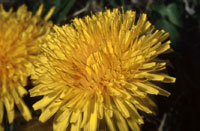Dear Umbra,
We moved into a suburban neighborhood in Ft. Collins, Colo., last year and I began my usual organic gardening practices. I created a beautiful flower garden in our front yard, but I still receive complaints from my neighbors because I refuse to apply herbicides to kill the dandelions and other weeds in the lawn. At least they are all green and neatly mowed! My scientific explanations about the dangers of herbicides and pesticides and the benefits of lawn biodiversity do not placate my picky neighbors. And they haven’t even seen my milkweed butterfly garden yet. Can there really be a product that is completely environmentally safe that would stop weeds from growing in the lawn?
Thank you,
Courtney Farrell
Dearest Courtney,
The real question here is, “Why has grass become a social obligation?” It seems that your most useful gardening tool is going to be persuasive speaking.

Dandelion whine.
I have several community-relations ideas for you. One would be to find several articles about the dangers of pesticides (complete with pictures of sickly farm workers and deformed frogs), laminate them, tape them on stakes, and stick them around your yard. Another idea: Make tiny yard banners similar to the ones lawn companies use, but sporting slogans like, “This lawn will not cause cancer,” or, “Lawn care by TLC not toxics,” or maybe, “Mind your own business.” Alternatively, if you’re the diplomatic type, you could teach a little class at the local community center on healthy, natural lawns. A good offense is the best defense.
For the benefit of our studio audience, let’s go over the basics of natural lawn care. A weed is simply a plant that is not desired, and each person has his or her own personal feelings about weeds and pests. Helping any plant thrive is a matter of cultivating healthy soil, encouraging natural organisms in the ecosystem, working with the natural cycles of pests and plants, and choosing the right plant for the right place. All plants, including grass, have places where they thrive naturally — but lawns made purely of mowable grass are unnatural in most of the U.S. Plants growing in compacted soil (common on housing sites) and in unnatural conditions are unhealthy, and unhealthy plants are the first to be attacked by pests and weeds. The best prevention is natural lawn care: soil improvement, thatch removal, overseeding with locally appropriate grass, and appropriate watering. (In this case, in other words, a good defense is the best offense.) Detailed information about natural lawn care, along with articulate arguments against pesticides and much more, is readily available through the Northwest Coalition for Alternatives to Pesticides.
If you’re still tearing at your hair and yelling at your monitor (“Okay, Umbrinski, but what the hell do I do about the weeds?”), then let me suggest that you revert to the technique used in the famous gardens of Versailles, the Summer Palace, and Monticello. What do you do with weeds? You weed! Stop those spawning plants in their tracks the old-fashioned way, with or without one of many new-fangled tools: a standing dandelion puller, say, or a flame-weeder. (This last really does exist, but it may not be a sensitive choice in Colorado this summer. On the other hand, if you were wielding a flame-weeder, I’m sure your neighbors would give you a wide berth.)
The substances you can use to combat weeds range from regular old white vinegar to everyone’s new favorite pre-emergent broadleaf herbicide, corn gluten. The corn gluten will come the closest to mimicking the crap your neighbors are paying for (you will take it out of the box, chuck it on the lawn, and go inside to watch TV), but it should be your tactic of last resort. Why? Because it is not necessarily Completely Environmentally Safe. Though vinegar and corn are both naturally occurring, the only response that will not disturb anything but weeds is … weeding. I’m sorry.
For other information on toxins, I heartily recommend the publications put out by the Washington Toxics Coalition, which rates home products on environmental and health safety. The booklets are filled with easy-to-read charts, which you can use not only to choose your own lawn products, but to begin discussions with your neighbors about theirs. It’s always helpful to have something official-looking in hand. And if you change their minds — well, that’s the best weed prevention of all.
Hoe on,
Umbra

